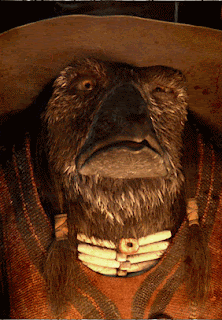(c) 2010 - Paramount Pictures (source)
Here's a good plot summary from Wikipedia:
"Rango is a chameleon who lives in a terrarium and constantly seeks to fit in with his surroundings. He finds himself removed from his contemporary American southwest surroundings and ends up in an Old West town in the middle of the Mojave Desert called Dirt, which is populated by various desert critters garbed like characters out of Western fiction. Thinking himself a hero, Rango establishes himself as the town's sheriff, not knowing that people who have held that title do not fare very well in Dirt."
My review for the film is available here. I gave it 2.5 out of 4 stars:
http://www.movieretriever.com/blog/1073/movie-review-rango
As I write in the review:
"The film plays like a classic Sergio Leone Spaghetti Western crossed with a Nickelodeon kid's comedy with a little Fear and Loathing in Las Vegas thrown in as well. As a Western, the movie has everything from high noon gun battles to bitter fights over water rights to the stereotypical stoic Indian who once again seems incapable of speaking in complete sentences."
That last part refers to the character Wounded Bird.
(c) 2011 - Paramount Pictures (source)
In the film, Wounded Bird plays a bit part as the token town Indian. He's quiet, mystical, and knows exactly how to track in the wilderness, just like the classic Hollywood Indian.
That being said, he is the source of some comic relief with his one-liners and ends up being a clearly heroic figure in the end. Then again, the bad pun where Rango refers to Wounded Bird's "ingenuity" only to say "no pun intended" put a bad taste in my mouth.
The official film website over at http://www.rangomovie.com/ includes this description of Wounded Bird:
"A solid creature of the Crow Nation. Wounded Bird draws his inspiration from Native American Indian principles of harmony and quiet observation. His tracking skills are legendary and he's big in Finland for some reason."
I disagree. Wounded Bird draws his inspiration directly from the scores of Indian depictions in countless Hollywood Westerns. Rango is filled with every other Western cliche- saloon brawls, corrupt mayors, spineless townfolk, a mysterious stranger- so why not the quiet mystical stereotypical Indian! It wouldn't be a true homage without one!
Personally, I'm a fan of subverting tired cliches and stereotypes to challenge our expectations and get those cerebral juices flowing. Rango does just that when the Beans character (voiced by Isla Fisher) subverts the traditional female role to become a gun-slinging, posse riding hero in her own right.
So why couldn't they have done the same thing with Wounded Bird?
(c) 2011 - Paramount Pictures (source)
I wonder if writer/director Gore Verbinski ever stopped to think about the Wounded Bird character or simply threw him in as another element in this ode to the Spaghetti Western. Considering Verbinski made his mark directing the Pirates of the Caribbean franchise, a fine trio of films full of old cliches and stereotypes, this new character shouldn't come as any surprise. It's just another example of modern Hollywood's love affair with the classic Hollywood Indian, even if he's an animated bird in a kids comedy.
And in case you're wondering, Wounded Bird is voiced by Gil Birmingham. He is of Comanche ancestry and is best known for his role in the Twilight series. I haven't heard his or anyone else's take on the character but I'm always open to other thoughts.
<>








